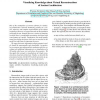Free Online Productivity Tools
i2Speak
i2Symbol
i2OCR
iTex2Img
iWeb2Print
iWeb2Shot
i2Type
iPdf2Split
iPdf2Merge
i2Bopomofo
i2Arabic
i2Style
i2Image
i2PDF
iLatex2Rtf
Sci2ools
CGI
1999
IEEE
1999
IEEE
Visualizing Knowledge about Virtual Reconstructions of Ancient Architecture
One of the assumptions of current software for visualizing architecture is that the underlying geometry is a correct, objective, and complete representation of the objects in question. However, we argue that such an ideal situation can hardly be met. Instead, there are a variety of situations in which there is considerable uncertainty associated with some features of a model. Furthermore, the model usually stems from design decisions which are not encoded in the model, but which may be important for users. We argue that more information about geometric models should be representable and visualizable. In particular, we propose non-photorealistic rendering styles for encoding such additional information in a visualization of a 3D model which goes over and above the geometry. We then apply this concept to visualizations of virtual reconstructions of ancient architecture. Finally, we describe the prototypical system ANCIENTVIS which represents an approach to visualizing models with uncert...
CGI 1999 | Computer Graphics | Considerable Uncertainty | Ideal Situation | Non-photorealistic Rendering Styles |
| Added | 02 Aug 2010 |
| Updated | 02 Aug 2010 |
| Type | Conference |
| Year | 1999 |
| Where | CGI |
| Authors | Thomas Strothotte, Maic Masuch, Tobias Isenberg |
Comments (0)

